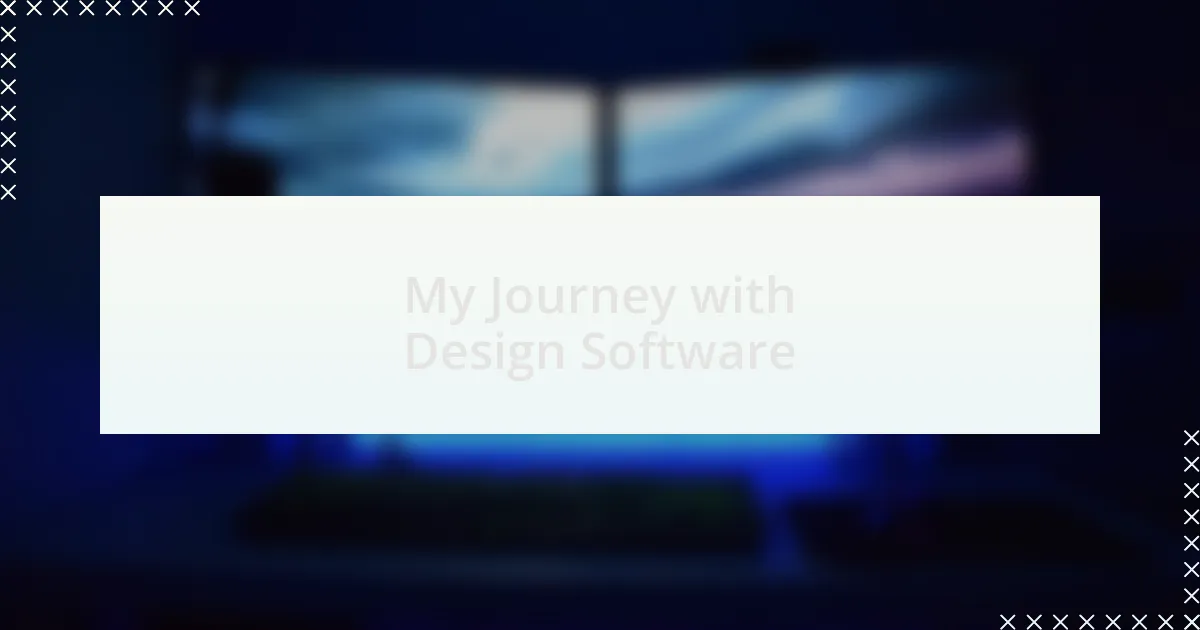Key takeaways:
- Understanding design software is crucial for enhancing creativity and aligning it with personal workflow.
- Popular design software like Adobe Creative Suite, Sketch, and Figma each offer unique features that can inspire creativity and support collaboration.
- Mastering design software involves exploring tutorials, practicing regularly, and engaging with other designers for feedback and new ideas.
- Future trends include AI-driven tools, cloud-based collaboration, and immersive augmented/virtual reality features that will transform the design process and client interactions.
Author: Oliver Bancroft
Bio: Oliver Bancroft is an accomplished author and storyteller known for his vivid narratives and intricate character development. With a background in literature and creative writing, Oliver’s work often explores themes of human resilience and the complexities of modern life. His debut novel, “Whispers of the Forgotten,” received critical acclaim and was nominated for several literary awards. In addition to his fiction, Oliver contributes essays and articles to various literary magazines. When he’s not writing, he enjoys hiking and exploring the great outdoors with his dog, Max. Oliver resides in Portland, Oregon.
Understanding design software
Design software serves as the backbone of modern creative work, making it crucial to understand its features and capabilities. I still recall my first exploration of design software—feeling overwhelmed yet exhilarated by all the options available. Have you ever paused to think about how the right tool can completely transform your design experience?
As I navigated through various programs, the significance of user interfaces became clear. Some software felt intuitive, while others required a steeper learning curve. Choosing the right software can either enhance your creativity or limit it. Have you experienced that moment of clarity when a specific tool clicks for you?
It’s worth noting that understanding design software isn’t just about learning its functions; it’s about understanding how it fits into your workflow. When I found the perfect balance between tools that complemented my creative process, it felt like unlocking a hidden level in a game. Have you found your perfect combination yet?
Popular design software options
When it comes to popular design software, Adobe Creative Suite often tops the list. I remember diving into Photoshop for the first time, captivated by the endless possibilities for photo manipulation and graphic design. Have you ever had that moment when a tool allows your imagination to run wild?
Another noteworthy option is Sketch, which has significantly influenced web and interface design. I recall the excitement of creating my first wireframe; Sketch’s user-friendly interface felt like having a blank canvas at my fingertips. Does your current software spark that same joy and creativity?
Lastly, I can’t overlook Figma, which fosters collaboration among designers. I experienced a breakthrough while working on a team project, where real-time editing allowed our ideas to flourish without the chaos of version control. Have you experienced the magic of seamless teamwork in design?
Tips for mastering design software
Tips for mastering design software can truly transform your creative process. One essential strategy I found effective is dedicating time to explore tutorials and online courses specific to the software you’re using. During my early days with Illustrator, I stumbled upon a series of YouTube videos that made complex functions feel approachable and even fun. Have you considered how much a few guided sessions can enhance your confidence and skill set?
Another tip is to practice regularly, even if it’s just for a few minutes each day. I made it a routine to redesign simple everyday objects in my spare time, which not only improved my proficiency but also injected a bit of playfulness into my practice. Think about what small projects you can take on that ignite your passion and keep your skills sharp.
Lastly, connect with other designers, whether through online communities or local meetups. I vividly recall the eye-opening feedback I received during a design workshop; it reshaped my perspective on color usage and composition. How often do you seek input from fellow creatives, and could it unlock new ways of thinking about your work? Engaging with others can lead to wonderful collaborations and insights that elevate your design journey.
Future trends in design software
As I look ahead, artificial intelligence is poised to revolutionize design software. Imagine software that can analyze your style preferences and suggest tailored design elements, learning from your every click and decision. The thought of having a collaborative AI partner that enhances creativity rather than replaces it excites me. Have you ever dreamed of tools that not only assist but anticipate your design needs?
Moreover, the trend of cloud-based collaboration is becoming increasingly vital. Working on shared platforms has made it so much easier for me to co-create with colleagues across the globe. I remember a late-night session with a team in different time zones; we seamlessly edited the same document in real time. Is this the future of teamwork that allows for continuous innovation and instant feedback?
Lastly, the integration of augmented and virtual reality features into design software is something I can’t wait to see unfold. I’ve always been fascinated by the concept of immersing clients in their designs before anything is built. Picture yourself walking through a 3D model of a website or a space you’re envisioning! How do you think these immersive experiences will transform client presentations and the design process? This trend has the potential to make design more interactive and help clients grasp concepts more intuitively.

Leave a Reply